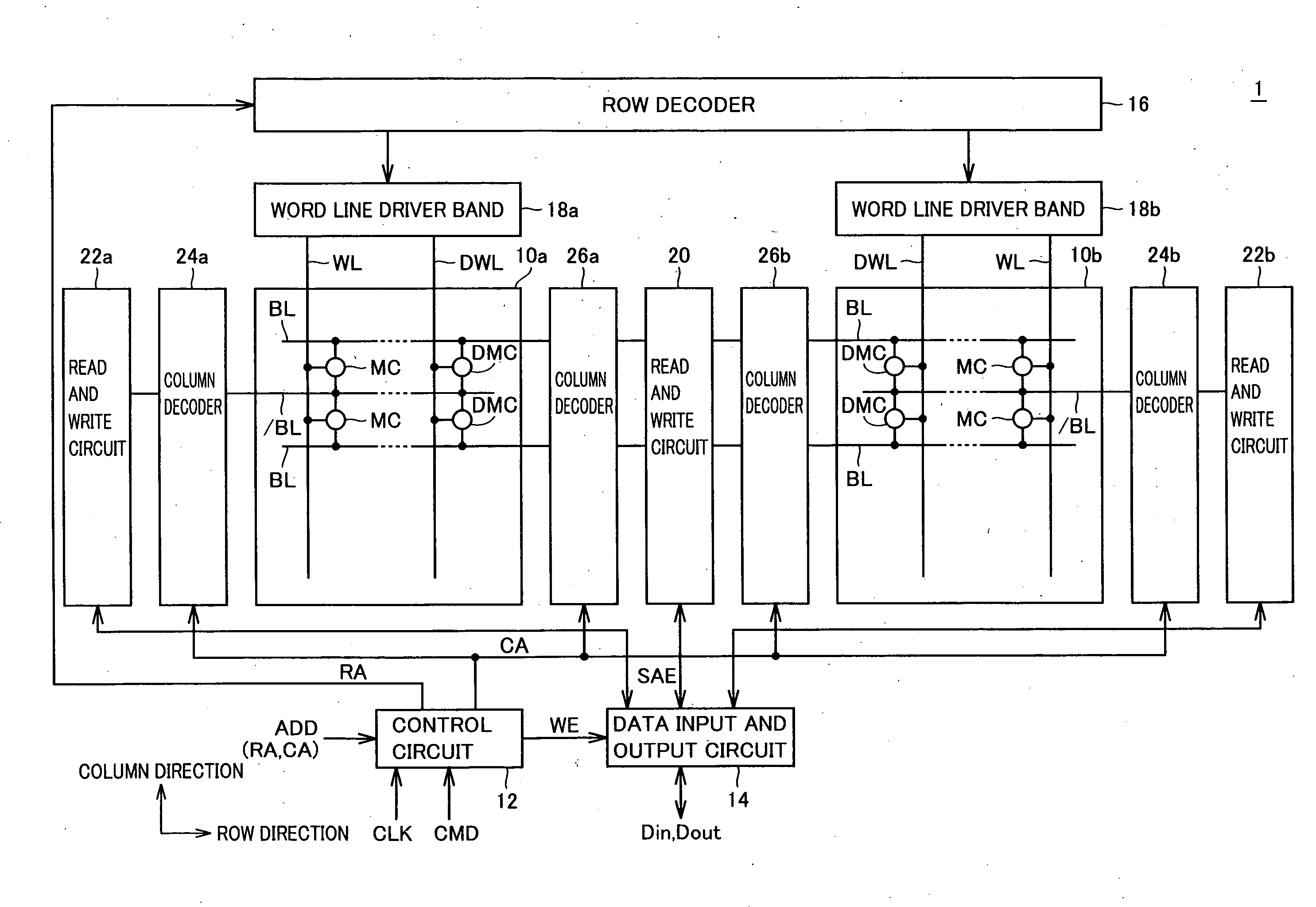Nonvolatile memory device
- Summary
- Abstract
- Description
- Claims
- Application Information
AI Technical Summary
Benefits of technology
Problems solved by technology
Method used
Image
Examples
first embodiment
[0041]FIG. 1 shows an entire configuration of an MRAM device 1 that is a typical example of the nonvolatile memory device, according to a first embodiment of the present invention.
[0042]Referring to FIG. 1, in response to externally supplied control signal CMD and address signal ADD, MRAM device 1 makes random access to write input data Din and read output data Dout. The data write operation and the data read operation of MRAM device 1 are performed, for example, at a timing synchronized with externally supplied clock signal CLK. The operation timing may be set internally without receiving clock signal CLK which is externally supplied.
[0043]MRAM device 1 includes a control circuit 12, memory arrays 10a, 10b, a row decoder 16, word line driver bands 18a, 18b, column decoders 24a, 24b, 26a, 26b, a data input and output circuit 14, and read and write circuits 20, 22a, 22b.
[0044]Control circuit 12 controls the whole operation of MRAM device 1 in response to externally supplied control ...
second embodiment
[0156]In connection with the first embodiment, the description is given of the MRAM memory device using the spin injection mechanism where the read current supply duration and the write current supply duration as well as respective values of the read and write currents are optimized in consideration of the thermal assist effect. In connection with a second embodiment, a description is given of an MRAM memory device using the spin injection mechanism where the read current supply direction is optimized in consideration of the thermal assist effect.
[0157]The entire configuration of the MR device that is a typical example of the semiconductor memory device and the schematic configuration of a memory array and its peripheral circuitry of the second embodiment of the present invention are similar to those in FIGS. 1 and 2 described above. Therefore, the detailed description thereof is not repeated. Further, memory cell MC which is a component of the MRAM device of the second embodiment o...
third embodiment
[0175]In connection with the second embodiment of the present invention, the tunneling magneto-resistance element is described for which there is a difference between the absolute value of the write current required for changing the electric resistance value from the high resistance state to the low resistance state and the absolute value of the write current required for changing the electric resistance value from the low resistance state to the high resistance state. In contrast, in connection with a third embodiment of the present invention, a tunneling magneto-resistance element is described for which respective absolute values of write currents required for causing the electric resistance value to the high and low resistance states are substantially equal to each other.
[0176]The entire configuration of the MRAM device that is a typical example of the nonvolatile memory device of the third embodiment and the schematic configuration of a memory array and its peripheral circuitry ...
PUM
 Login to View More
Login to View More Abstract
Description
Claims
Application Information
 Login to View More
Login to View More - R&D
- Intellectual Property
- Life Sciences
- Materials
- Tech Scout
- Unparalleled Data Quality
- Higher Quality Content
- 60% Fewer Hallucinations
Browse by: Latest US Patents, China's latest patents, Technical Efficacy Thesaurus, Application Domain, Technology Topic, Popular Technical Reports.
© 2025 PatSnap. All rights reserved.Legal|Privacy policy|Modern Slavery Act Transparency Statement|Sitemap|About US| Contact US: help@patsnap.com



